Stability Analysis of the Surrounding Rock of Deep Underground Engineering Under the Action of Thermal-Solid Coupling
Abstract
1. Introduction
2. Thermal-Solid Coupling Analysis Based on Finite Difference Method
3. Numerical Modeling of Deep Underground Engineering Determination
3.1. Numerical Modeling Establishment and Parameter Determination
3.2. Boundary Conditions and Numerical Calculation Scheme
4. Results and Analysis of Thermal-Solid Coupling Simulation
4.1. Multi-Field Evolution Patterns of Surrounding Rock Under Different Original Rock Temperatures
4.1.1. Evolution Patterns of Surrounding Rock Temperature Field
4.1.2. Evolution Patterns of Surrounding Rock Displacement Field
4.1.3. Evolution Patterns of Surrounding Rock Stress Field
4.1.4. Evolution Patterns of Plastic Zone of Surrounding Rock
4.2. Multi-Field Evolution Patterns of Surrounding Rock Under Continuous Excavation
4.2.1. Evolution Patterns of Surrounding Rock Temperature Field
4.2.2. Evolution Patterns of Surrounding Rock Displacement Field
5. Discussion
5.1. Disaster Forms Caused by High Rock Temperature
5.2. Effect of Thermal-Solid Coupling on Surrounding Rock Stability
5.3. Engineering Value and Prevention Measures
6. Conclusions
- After the completion of the three excavations, the distribution pattern of the isotherm was consistent with the geometric characteristics of the contour surface of the cavern. The temperature of the surrounding rock near the contour surface of the cavern was lower, but the temperature gradient was larger. At the same time, the temperature gradient of the surrounding rock gradually increased with the increase in the original rock temperature, and the temperature of the deep surrounding rock tended towards the original rock temperature.
- After the excavation, the greatest vertical displacement was observed at the vault and the bottom of the arch, and the lager horizontal displacement occurred in the middle of the sidewall of the cavern. Under different original rock temperature conditions, the vertical displacement exhibited a vault settlement value > the arch bottom uplift value. As the original rock temperature climbed from 30 °C to 90 °C, the increment of vault displacement was 2.45 times that of arch bottom displacement, and the influence of temperature change on the vault was more significant. At the same time, the horizontal displacement at different temperatures exhibited sidewall displacement > spandrel displacement > skewback displacement.
- The maximum principal stress was mainly compressive stress in a certain range of the contour surface of the cavern, and the tensile stress concentration phenomenon occurred in a small range. With the increase in temperature, the stress concentration degree further increased, and the concentration phenomenon at the spandrel and skewback on both sides was more obvious. The minimum principal stress was mainly compressive stress, and the variation range and stress concentration degree of the minimum principal stress on both sides of the cavern increased obviously with the increase in the original rock temperature.
- There was a direct relationship between the distribution area of the plastic zone and the temperature of the surrounding rock. The higher the original rock temperature, the greater the depth of the plastic zone. The types of plastic zones in the surrounding rock were mainly characterized by shear stress-induced yielding and tensile stress-induced damage failure. When the original rock temperature increased from 30 °C to 90 °C, the rock mass extending up to 1.5 m from the excavation contour surface formed a large area of damage zone, and the plastic zone changed from sporadic distribution on the contour surface of the cavern to the gradual convergence to form a large-scale plastic zone, and the area of the plastic zone increased obviously.
- During the continuous excavation of deep underground engineering, the thermostat ring diffused to the depth in a ring centered on the middle of the cavern. The closer the working face was to the monitoring section, the faster the temperature dropped at the monitoring surface and the greater the displacement change. When the working face advanced to the monitoring section, the speed of the monitoring section temperature decreased the fastest, and the displacement changed the most. When the excavation continued to the rear of the monitoring section, the temperature continued to decline, and the deformation continued to increase, but the rate of change decreased significantly.
Author Contributions
Funding
Data Availability Statement
Acknowledgments
Conflicts of Interest
References
- Schaumann, M.; Gamba, D.; Morales, H.G.; Corsini, R.; Guinchard, M.; Scislo, L.; Wenninger, J. The effect of ground motion on the LHC and HL-LHC beam orbit. Nucl. Instrum. Methods Phys. Res. Sect. A 2023, 1055, 168495. [Google Scholar] [CrossRef]
- Cai, Y.F.; Jin, Y.T.; Wang, Z.Y.; Chen, T.; Wang, Y.R.; Kong, W.Y.; Xiao, W.; Li, X.J.; Lian, X.G.; Hu, H.F. A review of monitoring, calculation, and simulation methods for ground subsidence induced by coal mining. Int. J. Coal Sci. Technol. 2023, 10, 32. [Google Scholar] [CrossRef]
- Zhao, Y.X.; Zhang, K.N.; Ling, C.W.; Guo, J.H.; Sun, B. A novel method combining strata movement and UAV infrared remote sensing technology to evaluate mining ground damage. Int. J. Coal Sci. Technol. 2024, 11, 83. [Google Scholar] [CrossRef]
- Łacny, Ł.; Ścisło, Ł.; Guinchard, M. Application of probabilistic power spectral density technique to monitoring the long-term vibrational behaviour of CERN seismic network stations. Vib. Phys. Syst. 2020, 31, 2020311. [Google Scholar]
- Liu, C.; Liu, Y.H.; Chen, Y.H.; Zhao, C.J.; Qiu, J.L.; Wu, D.Y.; Liu, T.; Fan, H.B.; Qin, Y.W.; Tang, K.J. A State-of-the-Practice Review of Three-Dimensional Laser Scanning Technology for Tunnel Distress Monitoring. J. Perform. Constr. Fac. 2023, 37, 03123001. [Google Scholar] [CrossRef]
- Barla, G. Full-face excavation of large tunnels in difficult conditions. J. Rock Mech. Geotech. Eng. 2016, 8, 294–303. [Google Scholar] [CrossRef]
- Panda, M.K.; Mohanty, S.; Pingua, B.M.P.; Mishra, A.K. Engineering geological and geotechnical investigations along the head race tunnel in Teesta Stage-III hydroelectric project, India. Eng. Geol. 2014, 181, 297–308. [Google Scholar] [CrossRef]
- Guo, X.S.; Fan, N.; Liu, Y.H.; Liu, X.L.; Wang, Z.K.; Xie, X.T.; Jia, Y.G. Deep seabed mining: Frontiers in engineering geology and environment. Int. J. Coal Sci. Technol. 2023, 10, 23. [Google Scholar] [CrossRef]
- Li, Y.T.; Gao, X.H. Assessment of variations in shear strain energy induced by fault coseismic slip in deep longwall mining. Int. J. Coal Sci. Technol. 2025, 12, 3. [Google Scholar] [CrossRef]
- Akdag, S.; Karakus, M.; Taheri, A.; Nguyen, G.; He, M.C. Effects of thermal damage on strain burst mechanism for brittle rocks under true-triaxial loading conditions. Rock Mech. Rock Eng. 2018, 51, 1657–1682. [Google Scholar] [CrossRef]
- Hu, Y.P.; Wang, M.N.; Wang, Q.L.; Liu, D.G.; Tong, J.J. Field test of thermal environment and thermal adaptation of workers in high geothermal tunnel. Build. Environ. 2019, 160, 106174. [Google Scholar]
- Geisler, T.; Voit, K.; Burger, U.; Cordes, T.; Lehner, F.; Götzl, G.; Wolf, M.; Marcher, T. Geothermal Potential of the Brenner Base Tunnel-Initial Evaluations. Processes 2022, 10, 972. [Google Scholar] [CrossRef]
- Wen, T.; Hu, Z.; Wang, Y.K.; Zhang, Z.H.; Sun, Y.S. Monitoring and analysis of geotemperature during the tunnel construction. Energies 2020, 15, 736. [Google Scholar] [CrossRef]
- Yu, S.Y.; Ren, X.H.; Zhang, J.X.; Sun, Z.H. Numerical simulation on the excavation damage of Jinping deep tunnels based on the SPH method. Geomech. Geophys. Geo-Energy Geo-Resour. 2023, 9, 1. [Google Scholar] [CrossRef]
- Yu, S.Y.; Yang, X.K.; Ren, X.H. Shear Damage simulations of rock masses containing fissure-holes using an improved SPH method. Materials 2023, 16, 2640. [Google Scholar] [CrossRef]
- Li, P.; Liu, Y.; Cai, M.F.; Miao, S.J.; Li, Y.; Wu, Y.F.; Gorjian, M. Contemporary stress state in the Zhao-Ping metallogenic belt, eastern China, and its correlation to regional geological tectonics. Int. J. Coal Sci. Technol. 2025, 12, 29. [Google Scholar] [CrossRef]
- Wang, S.Y.; Yu, S.Y.; Hu, X.Y.; Yang, B.K. Effects of folded fissure properties on tunnel model failure: Experiments and numerical simulations. Eng. Fract. Mech. 2024, 310, 110487. [Google Scholar] [CrossRef]
- Hu, X.Y.; Huang, S.B.; Yu, S.Y.; Li, Y.F.; Dong, J.G. Investigations on the fracture mechanisms of Z-shaped fissured rock-like specimens. Theor. Appl. Fract. Mech. 2024, 134, 104748. [Google Scholar] [CrossRef]
- Yan, F.Y.; Wang, E.Z.; Liu, X.L.; Qi, C.Z.; Jia, W. Experimental study on strain localization and slow deformation evolution in small-scale specimens. Int. J. Coal Sci. Technol. 2015, 12, 30. [Google Scholar] [CrossRef]
- Hu, X.Y.; Huang, S.B.; Yu, S.Y.; Li, Y.F.; Wang, X.Y. Study on the interaction mechanisms between the fissure arrays and circular tunnels by physical experiment and meshless numerical method. Theor. Appl. Fract. Mech. 2025, 138, 104935. [Google Scholar] [CrossRef]
- Yao, X.C.; Li, N.; Wang, K.C.; Lv, G.; He, M.M. Experimental and analytical study on mechanical properties of high rock temperature diversion tunnel. Adv. Civ. Eng. 2019, 2019, 9537153. [Google Scholar] [CrossRef]
- Xin, L.; Li, J.Z.; Niu, M.F.; Li, C.; Wu, J.; Wang, B.W.; Xu, W.H.; Feng, M.Z.; Ma, Y. Numerical simulation of thermo-solid coupling under the condition of unidirectional heating of underground coal gasification overlying rock. Asia-Pac. J. Chem. Eng. 2023, 18, e2890. [Google Scholar] [CrossRef]
- Wu, Z.H.; Song, H.L.; Li, L.P.; Zhou, Z.Q.; Zou, Y.J.; Sun, W.J.B.; Liu, H.; Lou, Y.L. Study on the damage evolution process and fractal of quartz-filled shale under thermal-mechanical coupling. Geofluids 2021, 2021, 8843120. [Google Scholar] [CrossRef]
- Mo, Z.G.; Jiang, H.B.; Hou, X.B. Three-dimensional numerical simulation analysis of temperature field in high ground temperature tunnel. Water Resour. Hydropower Eng. 2017, 48, 57–62. [Google Scholar]
- Meng, W.; He, C.; Zhang, J.B. Inversion analysis of initial ground stress field of rock mass under high ground temperature and high ground stress. Chin. J. Rock Mech. Eng. 2020, 39, 749–760. [Google Scholar]
- Birch, F. Flow of heat in the front range, colorado. Geol. Soc. Am. Bull. 1950, 61, 567–630. [Google Scholar] [CrossRef]
- Shao, Z.S.; Qiao, R.J.; Wang, X.Y. Elastic theoretical solution of temperature and thermal stress field in high ground temperature tunnel. Rock Soil Mech. 2013, 34, 1–8. [Google Scholar]
- Che, J.G.; Li, A.G.; Guo, J.N.; Ma, Y.Q.; Li, J.X.; Yang, C.Q.; Che, L.F. Theoretical and experimental investigation on the thermal penetration depth in the surrounding rock of a deeply buried high-temperature tunnel. Int. J. Therm. Sci. 2024, 198, 108876. [Google Scholar] [CrossRef]
- Yin, Y.C.; Jiang, H.B.; Zhang, J.; Lu, G.D.; Li, Q.L. The influence of rock thermal stress on the morphology and expansion pattern of the plastic zone in the surrounding rock of a deep-buried tunnel under high geothermal temperature conditions. Appl. Sci. 2024, 14, 7589. [Google Scholar] [CrossRef]
- Zhu, Y.M.; Chen, S.G. Research on temperature field monitoring and construction cooling technology of high geothermal tunnel. Subgrade Eng. 2019, 3, 115–119. [Google Scholar]
- Li, T.B.; Pan, H.R.; Chen, G.Q.; Meng, L.B. Physical model test of temperature effect of tunnel rockburst under thermal-mechanical effect. Chin. J. Rock Mech. Eng. 2018, 37, 261–273. [Google Scholar]
- Sun, S.B.; Yan, S.H.; Cao, X.P.; Zhang, W. Distribution law of the Initial temperature field in a railway tunnel with high rock temperature: A model test and numerical analysis. Appl. Sci. 2023, 13, 1638. [Google Scholar] [CrossRef]
- Yu, S.Y.; Huang, S.B.; Li, Y.F.; Liang, Z.L. Insights into the frost cracking mechanisms of concrete by using the coupled thermo-hydro-mechanical-damage meshless method. Theor. Appl. Fract. Mech. 2025, 136, 104814. [Google Scholar] [CrossRef]
- Li, K.B.; Jiang, H.B.; Wei, G.; Xiang, P.F. Evolution characteristics of plastic zone in jointed rock mass of high-temperature hydraulic tunnel. Appl. Sci. 2023, 13, 11005. [Google Scholar] [CrossRef]
- Xu, D.; Zhang, B.W.; Ai, Z.B.; Bo, X.B.; Pan, H.B.; Chen, S.J. Spatial-temporal evolution principle of temperature field in a high-temperature geothermal highway tunnel. Ain Shams Eng. J. 2023, 14, 101965. [Google Scholar] [CrossRef]
- Li, J.B.; Meng, S.W.; Wang, S.L.; Liu, H.; Dong, K.X.; Lu, Q.Y. The propagation mechanism of elastoplastic hydraulic fracture in deep reservoir. Int. J. Coal Sci. Technol. 2025, 12, 21. [Google Scholar] [CrossRef]
- Yu, S.Y.; Ren, X.H.; Zhang, J.X. Using an improved SPH algorithm to simulate thermo-hydro-mechanical-damage coupling problems in rock masses. Case Stud. Therm. Eng. 2023, 47, 103085. [Google Scholar] [CrossRef]
- Jia, S.P.; Wu, B.; Chen, W.Z.; Wu, G.J.; Gao, M.; Gong, J. Stability analysis of surrounding rock of deep buried tunnel under thermal-stress-damage coupling effect. Rock Soil Mech. 2014, 35, 2375–2384. [Google Scholar]
- Jiang, C. Research on the Design Method of Primary Support Structure of High Ground Temperature Tunnel Based on Thermal-Mechanical Coupling Effect. Doctoral Dissertation, Southwest Jiaotong University, Chengdu, China, 2022. Available online: https://kns.cnki.net/kcms2/article/abstract?v=N5Mfx_KcSpIUQeAZs30uWaPu7S8WsvPFyKOf9e0odwrpXTRXr7EFWC4_JrlZhv5r9T0g_lUSzhSdehrG6VlHdwTJvFDA83l1p6xlsxikQA81jLnzAGj52eCrWbDgdEkdk3pnpNqdg1y6AlZg2Sv5OWpor8vCLzidC0aP4VxvdBc=&uniplatform=NZKPT (accessed on 25 March 2025).
- Zhao, M.; Guo, J.Q.; Li, S.H.; Liang, S.F.; Sun, F.Y. Stability analysis of surrounding rock and initial support of tunnel undercrossing multi-situational goafs: A reference of construction guidance. Appl. Sci. 2024, 14, 7412. [Google Scholar] [CrossRef]
- Cui, G.Y.; Wei, Y.F.; Xiong, Y.; Wang, D.Y.; Tian, X.L. Study on the ambient temperature control technology for construction of a tunnel near heat-conducting fault and with high rock temperature. Mod. Tunn. Technol. 2023, 60, 246–254. [Google Scholar]
- Yan, J.; He, C.; Wang, B.; Xu, G.; Wu, F.Y. Study on the characteristics and mechanism of rock burst in high geothermal and high stress tunnel. J. China Rallway Soc. 2020, 42, 186–194. [Google Scholar]
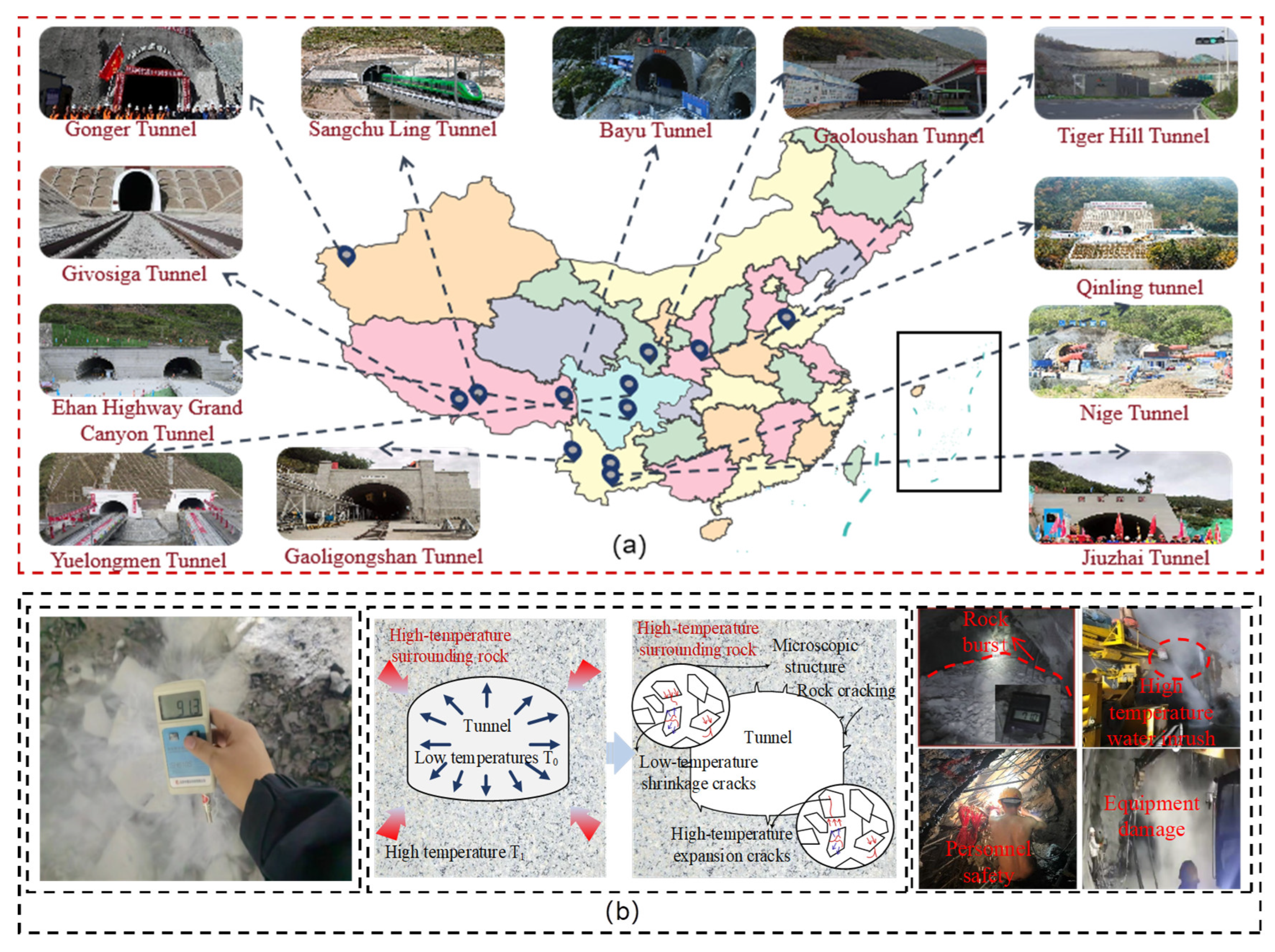
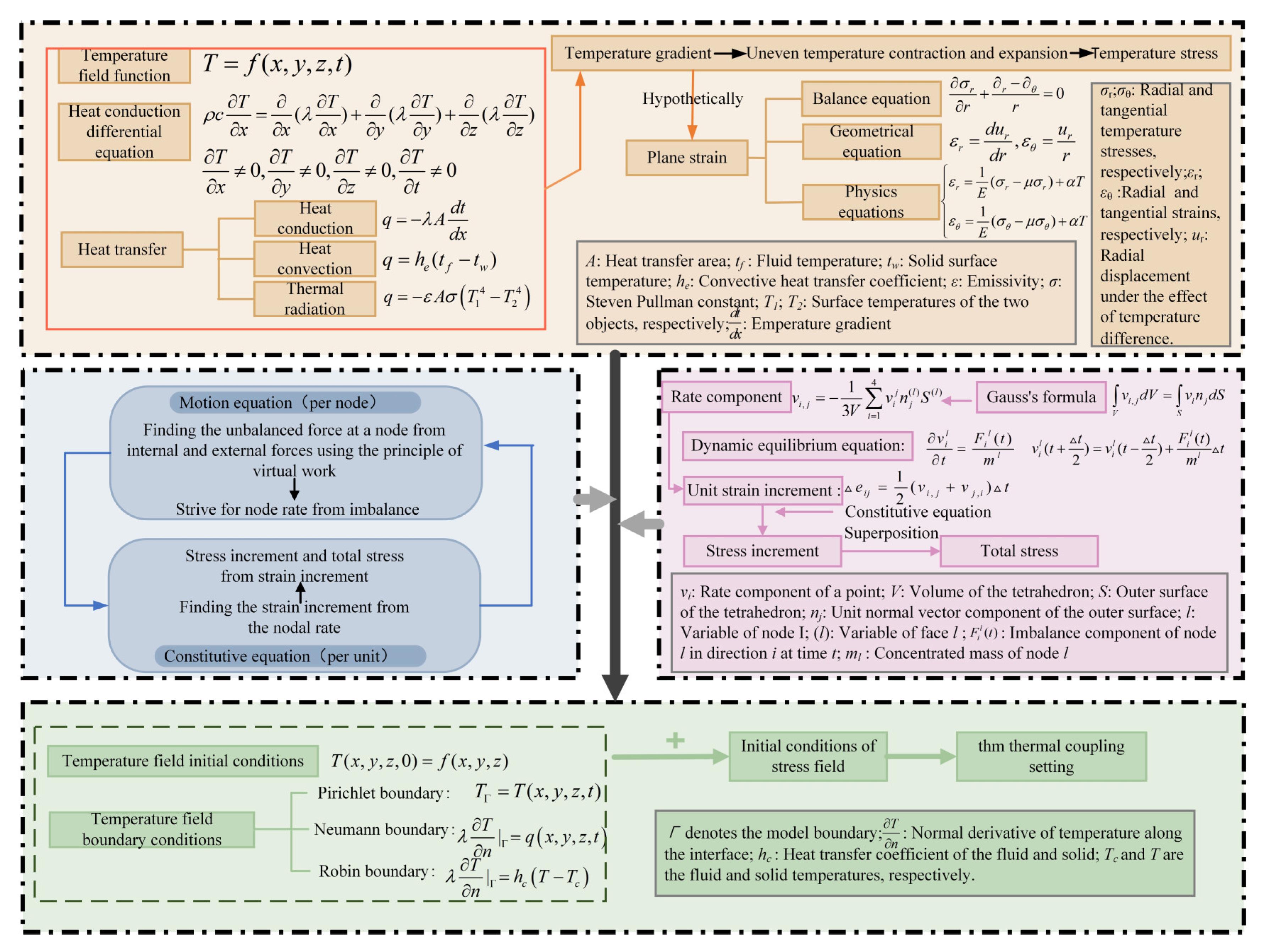
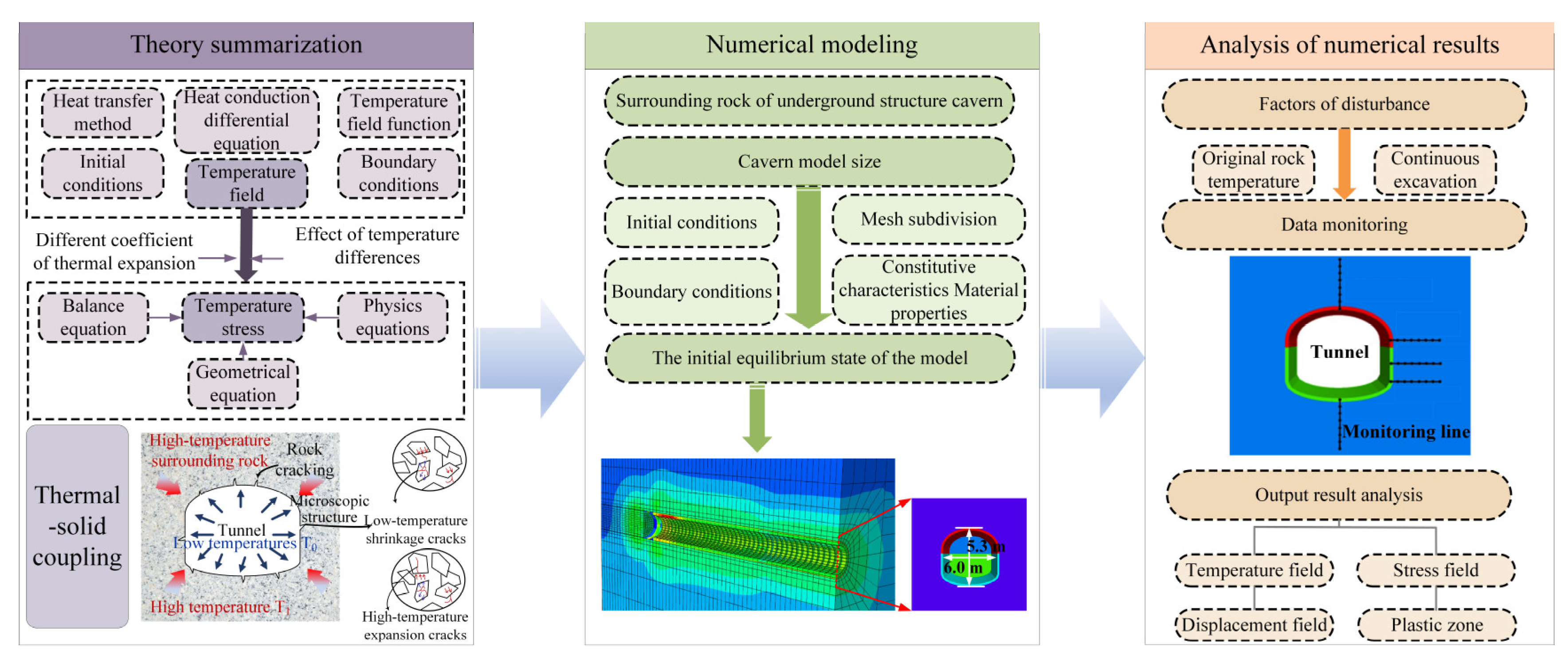
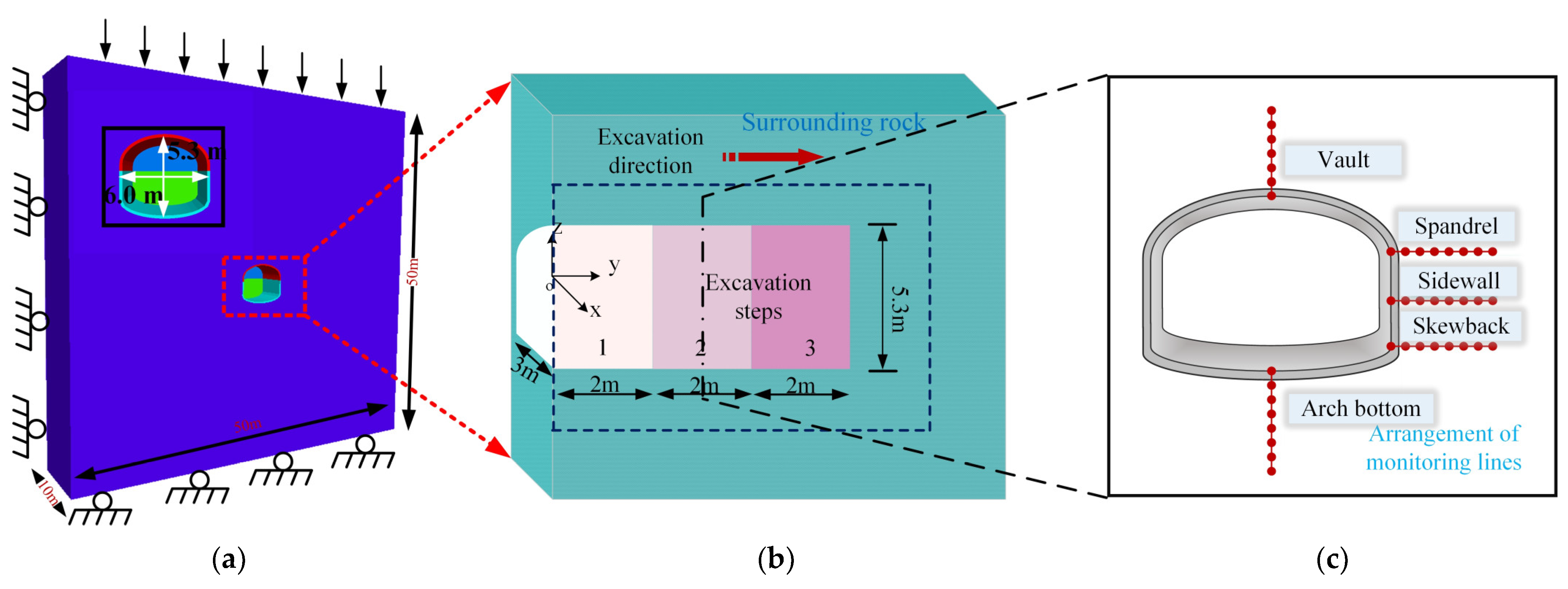
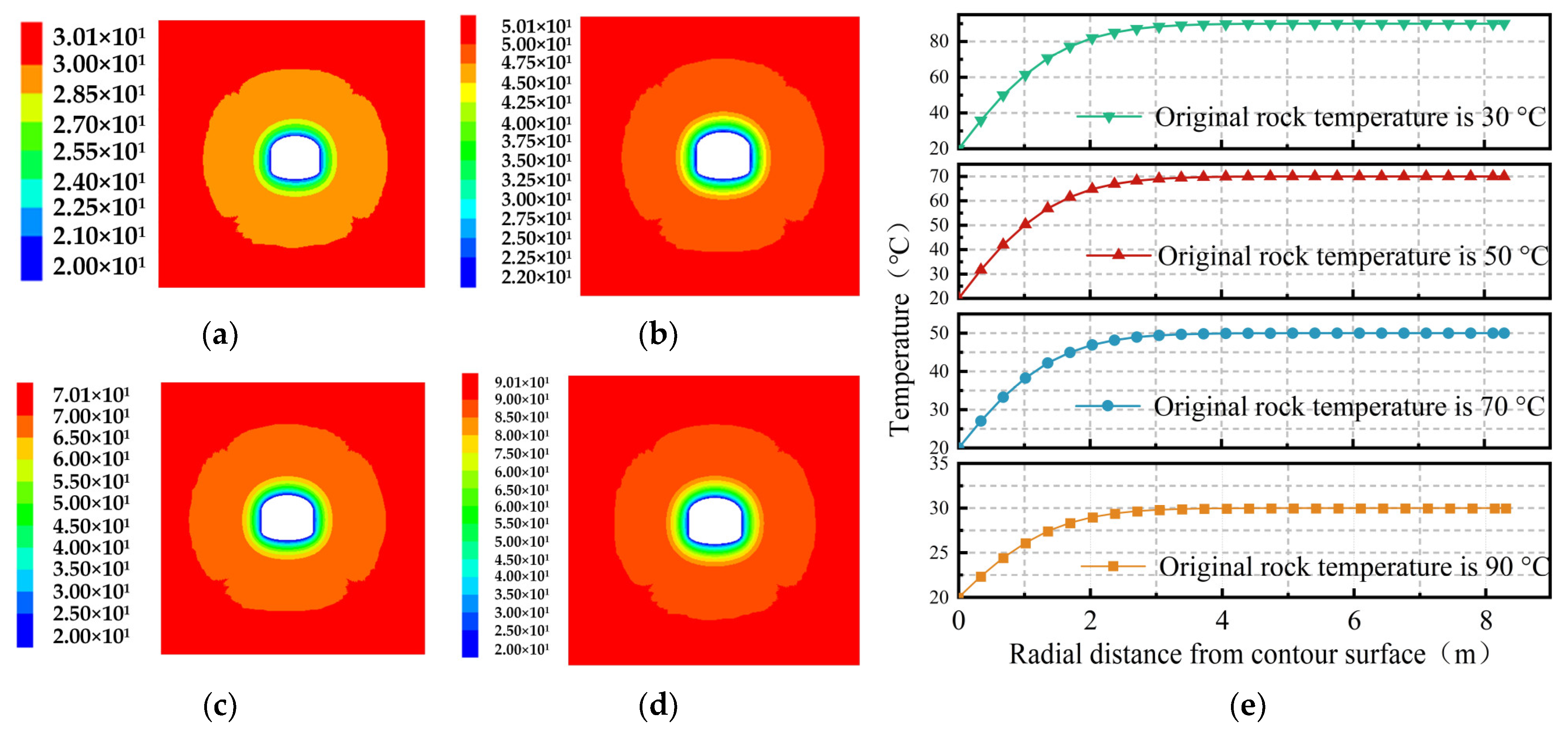
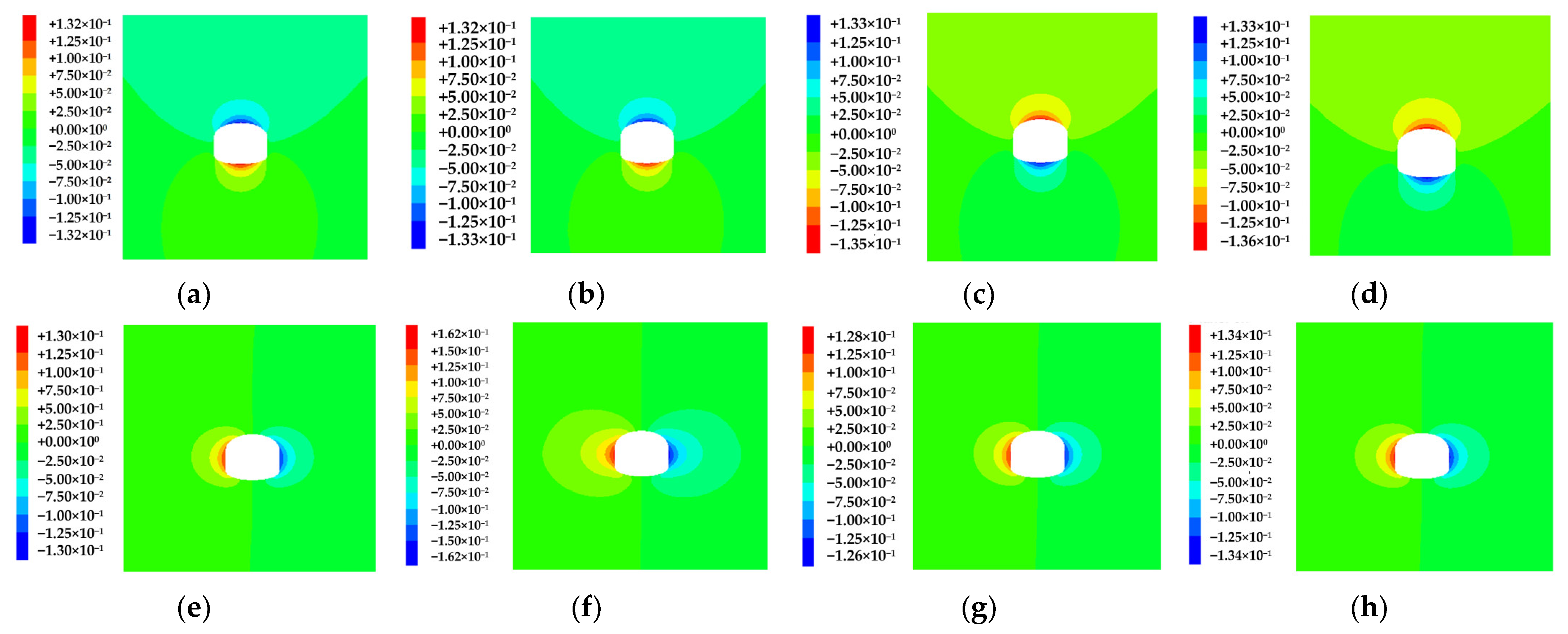
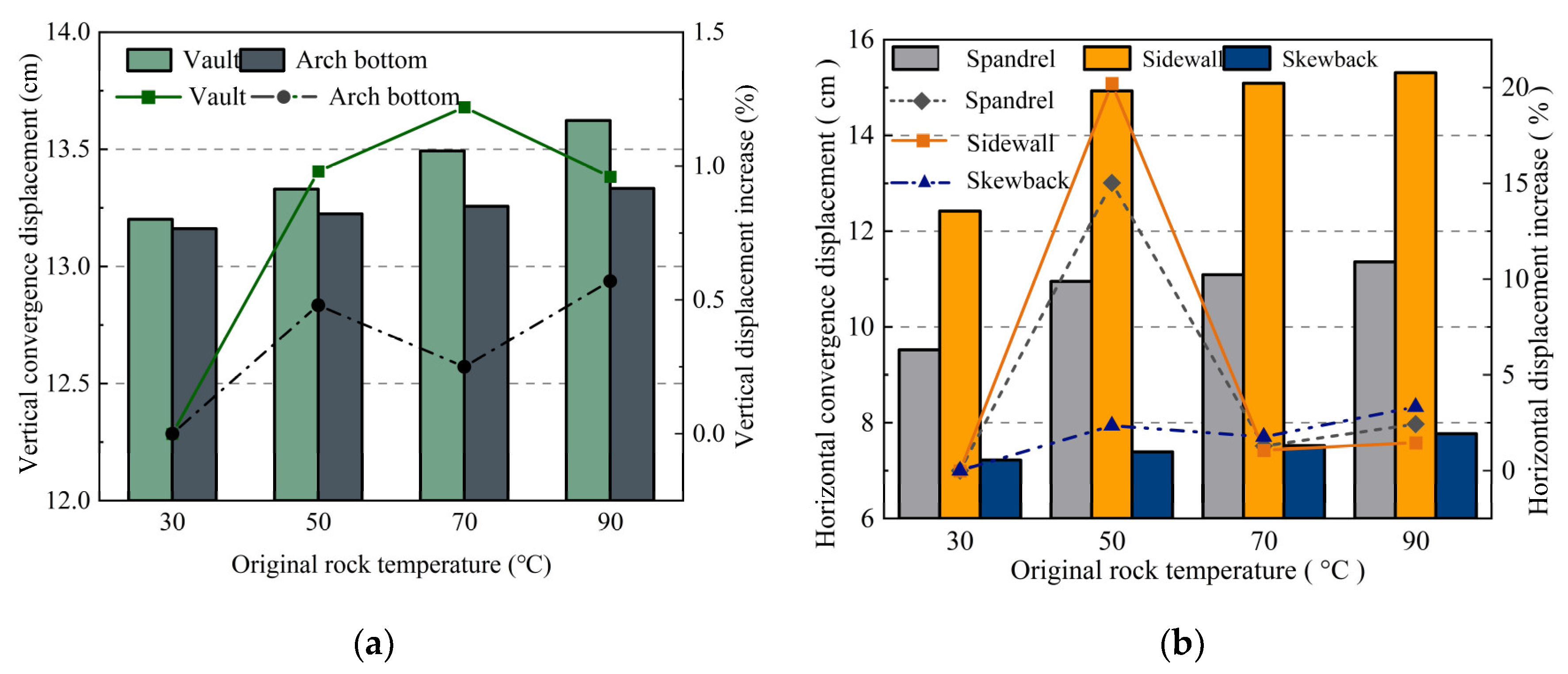
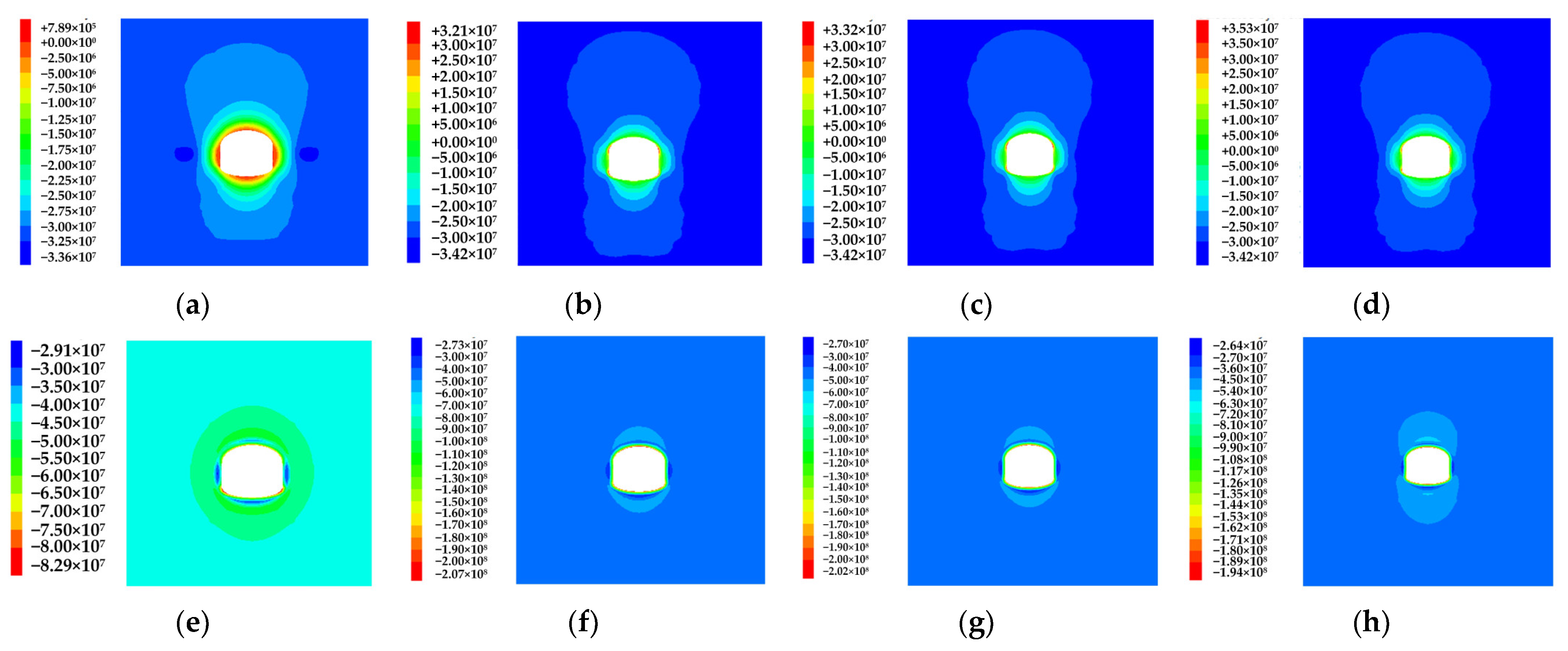
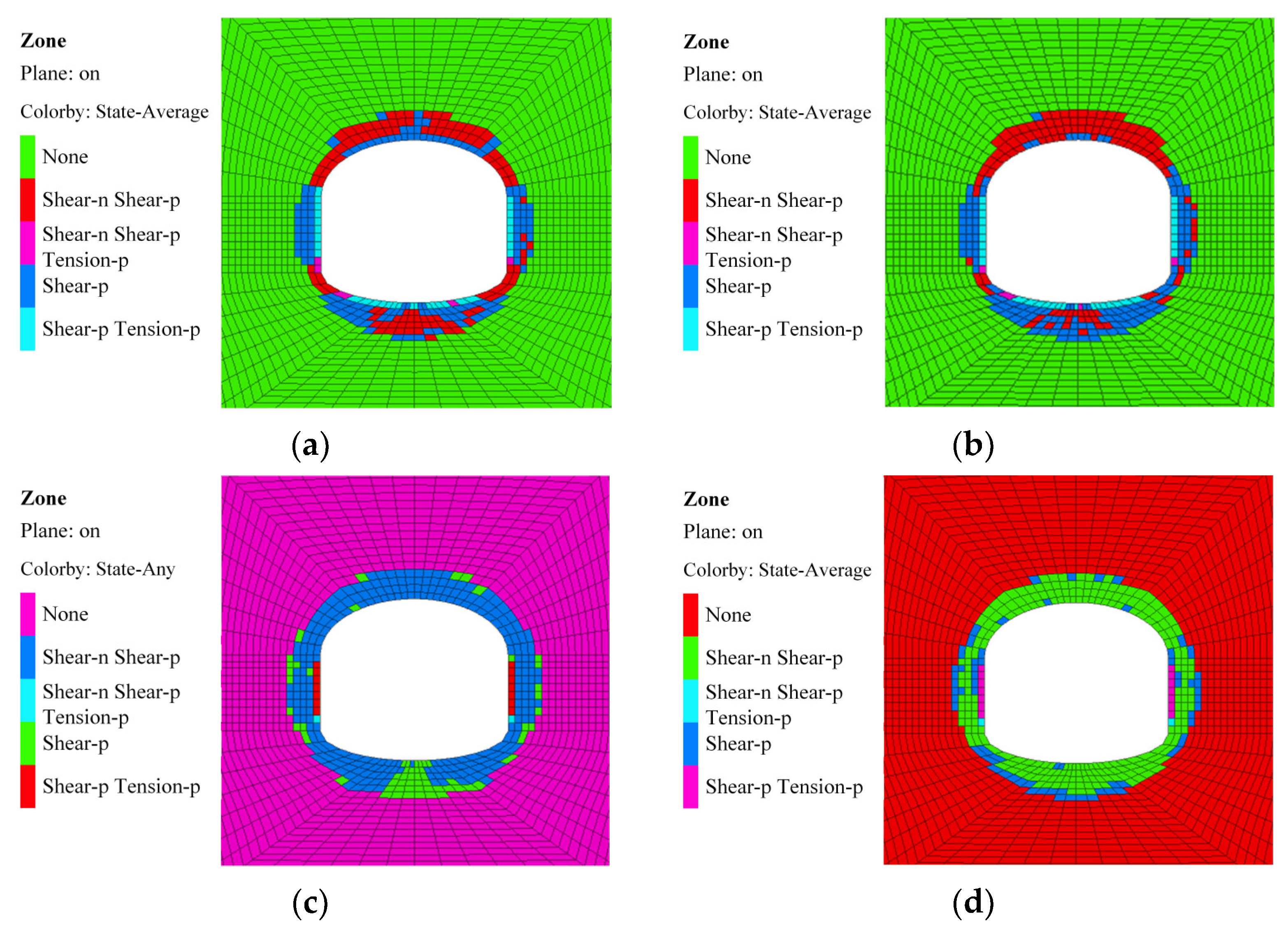

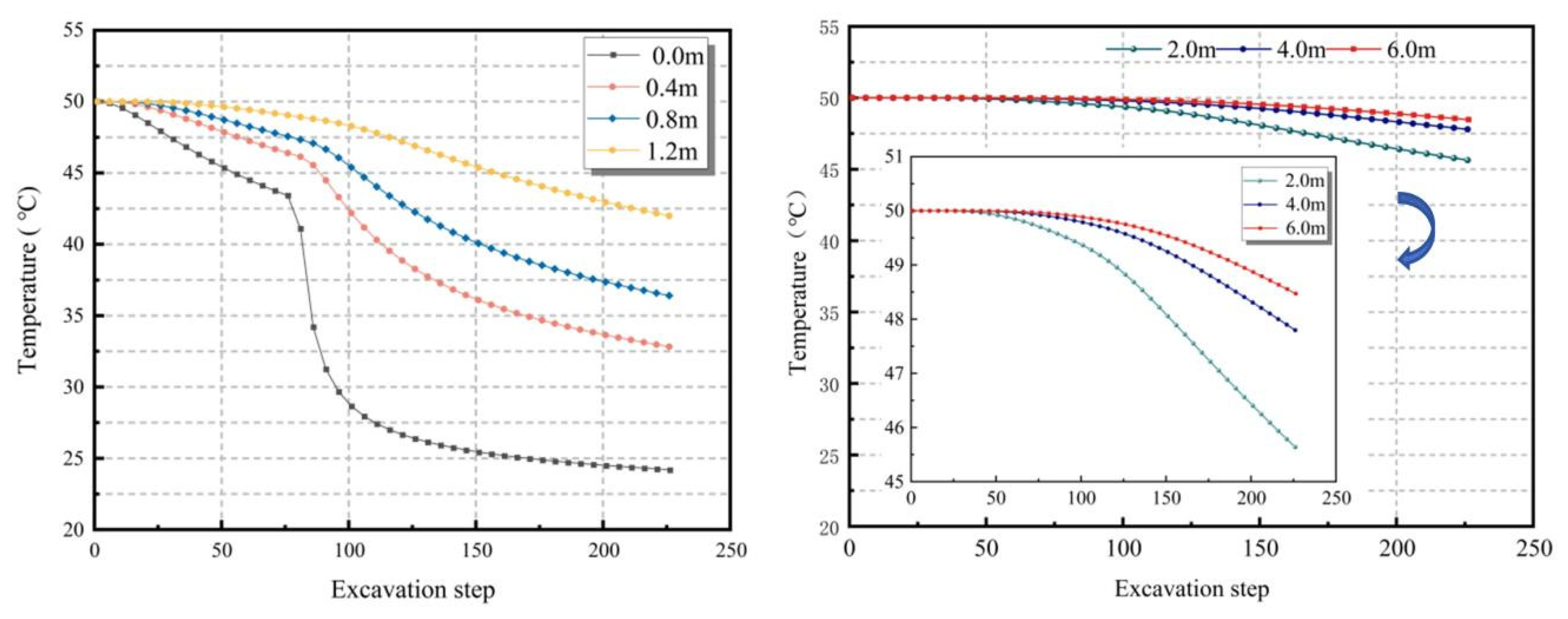


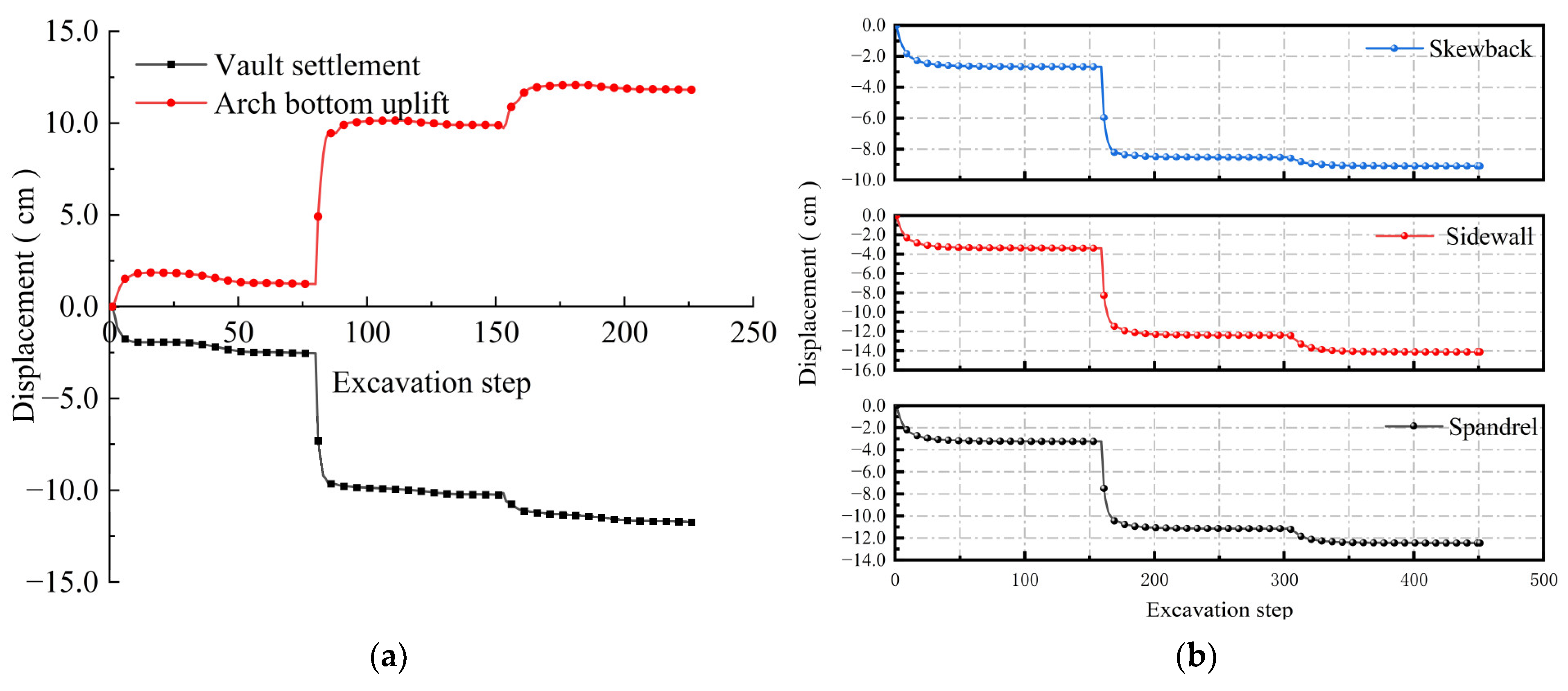
| Material Type | Density (kg/m3) | Shear Modulus (GPa) | Bulk Modulus (GPa) | Cohesive Force (MPa) | Angle of Internal Friction (°) | Thermal Conductivity (W/(m·°C)) | Specific Heat J/(kg·°C) | Coefficient of Linear Thermal Expansion (1/°C) |
|---|---|---|---|---|---|---|---|---|
| Surrounding rock | 2500 | 3.36 | 5.38 | 7.8 | 24.5 | 2.78 | 840 | 1 × 10−5 |
| initial spray | 2000 | 12.6 | 20.7 | —— | —— | —— | — | — |
| Elastic Modulus (GPa) | Tensile Strength (N/mm2) | Slurry Cohesion (MPa) | Cement Slurry Stiffness (GPa) | Friction Angle of Slurry (°) | Outer Perimeter of Cement Slurry (m) | Cross-Section (m2) |
|---|---|---|---|---|---|---|
| 200 | 400 | 0.8 | 0.7 | 30 | 1.0 | 1.52 × 10−3 |
| °C | m | ||
|---|---|---|---|
| 1: Different original rock temperature | 1-1 | 30 | 6 |
| 1-2 | 50 | 6 | |
| 1-3 | 70 | 6 | |
| 1-4 | 90 | 6 | |
| 2: Different excavation processes | 2-1 | 50 | 2 |
| 2-2 | 50 | 4 | |
| 2-3 | 50 | 6 | |
Disclaimer/Publisher’s Note: The statements, opinions and data contained in all publications are solely those of the individual author(s) and contributor(s) and not of MDPI and/or the editor(s). MDPI and/or the editor(s) disclaim responsibility for any injury to people or property resulting from any ideas, methods, instructions or products referred to in the content. |
© 2025 by the authors. Licensee MDPI, Basel, Switzerland. This article is an open access article distributed under the terms and conditions of the Creative Commons Attribution (CC BY) license (https://creativecommons.org/licenses/by/4.0/).
Share and Cite
Dou, X.; Shi, H.; Qing, Y.; Guo, J.; Cheng, L. Stability Analysis of the Surrounding Rock of Deep Underground Engineering Under the Action of Thermal-Solid Coupling. Buildings 2025, 15, 1500. https://doi.org/10.3390/buildings15091500
Dou X, Shi H, Qing Y, Guo J, Cheng L. Stability Analysis of the Surrounding Rock of Deep Underground Engineering Under the Action of Thermal-Solid Coupling. Buildings. 2025; 15(9):1500. https://doi.org/10.3390/buildings15091500
Chicago/Turabian StyleDou, Xiaoyu, Hongbin Shi, Yanbo Qing, Jiaqi Guo, and Lipan Cheng. 2025. "Stability Analysis of the Surrounding Rock of Deep Underground Engineering Under the Action of Thermal-Solid Coupling" Buildings 15, no. 9: 1500. https://doi.org/10.3390/buildings15091500
APA StyleDou, X., Shi, H., Qing, Y., Guo, J., & Cheng, L. (2025). Stability Analysis of the Surrounding Rock of Deep Underground Engineering Under the Action of Thermal-Solid Coupling. Buildings, 15(9), 1500. https://doi.org/10.3390/buildings15091500








